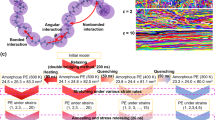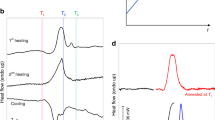Abstract
Polymers are usually considered thermal insulators, because the amorphous arrangement of the molecular chains reduces the mean free path of heat-conducting phonons. The most common method to increase thermal conductivity is to draw polymeric fibres, which increases chain alignment and crystallinity, but creates a material that currently has limited thermal applications. Here we show that pure polythiophene nanofibres can have a thermal conductivity up to ∼4.4 W m–1 K–1 (more than 20 times higher than the bulk polymer value) while remaining amorphous. This enhancement results from significant molecular chain orientation along the fibre axis that is obtained during electropolymerization using nanoscale templates. Thermal conductivity data suggest that, unlike in drawn crystalline fibres, in our fibres the dominant phonon-scattering process at room temperature is still related to structural disorder. Using vertically aligned arrays of nanofibres, we demonstrate effective heat transfer at critical contacts in electronic devices operating under high-power conditions at 200 °C over numerous cycles.
This is a preview of subscription content, access via your institution
Access options
Subscribe to this journal
Receive 12 print issues and online access
$259.00 per year
only $21.58 per issue
Buy this article
- Purchase on Springer Link
- Instant access to full article PDF
Prices may be subject to local taxes which are calculated during checkout




Similar content being viewed by others
Change history
17 June 2014
In the version of this Article originally published, in the section 'Thermal conductivity of individual fibres', the second sentence should have read "The measured thermal conductivity of the several nanofibre samples increases with decreasing diameter..." This error has now been corrected in the online versions of the Article.
References
Choy, C. L. Thermal conductivity of polymers. Polymer 18, 984–1004 (1977).
Henry, A. Thermal transport in polymers. Ann. Rev. Heat Transfer http://dx.doi.org/10.1615/AnnualRevHeatTransfer.2013006949 (2013).
Han, Z. D. & Fina, A. Thermal conductivity of carbon nanotubes and their polymer nanocomposites: a review. Prog. Polym. Sci. 36, 914–944 (2011).
Wang, X., Ho, V., Segalman, R. A. & Cahill, D. G. Thermal conductivity of high-modulus polymer fibers. Macromolecules 46, 4937–4943 (2013).
Liu, J. & Yang, R. Length-dependent thermal conductivity of single extended polymer chains. Phys. Rev. B 86, 104307 (2012).
Arkadii, A., Michael, B., Oleg, G. & Eyal, Z. Effect of supramolecular structure on polymer nanofibre elasticity. Nature Nanotech. 2, 59–62 (2007).
Choy, C. L., Wong, Y. W., Yang, G. W. & Kanamoto, T. Elastic modulus and thermal conductivity of ultradrawn polyethylene. J. Polym. Sci. 37, 3359–3367 (1999).
Lim, C., Tan, E. & Ng, S. Effects of crystalline morphology on the tensile properties of electrospun polymer nanofibers. Appl. Phys. Lett. 92, 141908 (2008).
Choy, C. L., Chen, F. C. & Luk, W. H. Thermal conductivity of oriented crystalline polymers. J. Polym. Sci. 18, 1187–1207 (1980).
Papkov, D. et al. Simultaneously strong and tough ultrafine continuous nanofibers. ACS Nano 7, 3324–3331 (2013).
Prasher, R. Thermal interface materials: historical perspective, status, and future directions. Proc. IEEE 94, 1571–1586 (2006).
Kurabayashi, K., Asheghi, M., Touzelbaev, M. & Goodson, K. E. Measurement of the thermal conductivity anisotropy in polyimide films. J. Microelectromech. Syst. 8, 180–191 (1999).
Lu, G. et al. Drying enhanced adhesion of polythiophene nanotubule arrays on smooth surfaces. ACS Nano 2, 2342–2348 (2008).
Xiao, R., Cho, S. I., Liu, R. & Lee, S. B. Controlled electrochemical synthesis of conductive polymer nanotube structures. J. Am. Chem. Soc. 129, 4483–4489 (2007).
Martin, C. R. Nanomaterials: a membrane-based synthetic approach. Science 266, 1961–1966 (1994).
Cannon, J. P., Bearden, S. D. & Gold, S. A. Effect of wetting solvent on poly (3-hexylthiophene)(P3HT) nanotubles fabricated via template wetting. Synth. Met. 160, 2623–2627 (2010).
Shen, S., Henry, A., Tong, J., Zheng, R. & Chen, G. Polyethylene nanofibres with very high thermal conductivities. Nature Nanotech. 5, 251–255 (2010).
Bazzaoui, E. A. et al. SERS spectra of polythiophene in doped and undoped states. J. Phys. Chem. 99, 6628–6634 (1995).
Louarn, G., Buisson, J. P., Lefrant, S. & Fichou, D. Vibrational studies of a series of alpha-oligothiophenes as model systems of polythiophene. J. Phys. Chem. 99, 11399–11404 (1995).
Shi, L. et al. Measuring thermal and thermoelectric properties of one-dimensional nanostructures using a microfabricated device. J. Heat Transfer 125, 881–888 (2003).
Cahill, D. G., Watson, S. K. & Pohl, R. O. Lower limit to the thermal conductivity of disordered crystals. Phys. Rev. B 46, 6131–6140 (1992).
Bullen, A. J., O'Hara, K. E., Cahill, D. G., Monteiro, O. & von Keudell, A. Thermal conductivity of amorphous carbon thin films. J. Appl. Phys. 88, 6317–6320 (2000).
Liu, X. et al. High thermal conductivity of a hydrogenated amorphous silicon film. Phys. Rev. Lett. 102, 035901 (2009).
Allen, P. B., Feldman, J. L., Fabian, J. & Wooten, F. Diffusons, locons and propagons: character of atomic vibrations in amorphous Si. Phil. Mag. B 79, 1715–1731 (1999).
Feldman, J. L., Kluge, M. D., Allen, P. B. & Wooten, F. Thermal conductivity and localization in glasses: numerical study of a model of amorphous silicon. Phys. Rev. B 48, 12589–12602 (1993).
Regner, K. T. et al. Broadband phonon mean free path contributions to thermal conductivity measured using frequency domain thermoreflectance. Nature Commun. 4, 1640 (2013).
Osinin, S. & Nosov, M. Relation between the speed of sound and the orientation of chain molecules in anisotropic systems. Mech. Compos. Mater. 2, 4–6 (1966).
Cola, B. A. et al. Photoacoustic characterization of carbon nanotube array thermal interfaces. J. Appl. Phys. 101, 054313 (2007).
Mohammad, F., Calvert, P. D. & Billingham, N. C. Thermal stability of electrochemically prepared polythiophene and polypyrrole. Bull. Mater. Sci. 18, 255–261 (1995).
Otiaba, K. et al. Thermal interface materials for automotive electronic control unit: trends, technology and R&D challenges. Microelectron. Reliab. 51, 2031–2043 (2011).
Cahill, D. G. & Pohl, R. O. Heat flow and lattice vibrations in glasses. Solid State Commun. 70, 927–930 (1989).
Choy, C. L., Tong, K. W., Wong, H. K. & Leung, W. P. Thermal conductivity of amorphous alloys above room temperature. J. Appl. Phys. 70, 4919–4925 (1991).
Taphouse, J. H. et al. Carbon nanotube thermal interfaces enhanced with sprayed on nanoscale polymer coatings. Nanotechnology 24, 105401 (2013).
Taphouse, J. H., Smith, O. N. L., Marder, S. R. & Cola, B. A. A pyrenylpropyl phosphonic acid surface modifier for mitigating the thermal resistance of carbon nanotube contacts. Adv. Funct. Mater. 24, 465–471 (2014).
Acknowledgements
This work was supported by the National Science Foundation (NSF; grant no. CBET-1133071), a seed grant from the Georgia Tech Center for Organic Photonics and Electronics and an NSF-IGERT graduate fellowship for T.L.B. The work of Y.C. was supported by the Air Force Office of Scientific Research (award no. FA9550-09-1-0162). The work of K.H.S. was supported by the US Department of Energy, Office of Basic Energy Sciences (award no. DE-SC0002245). The work at UT Austin was supported by the NSF (award no. CBET-0933454). A.W. acknowledges support from the NSF Graduate Research Fellowship Program. K.D.B. was supported by the Natural Science Foundation of China (award no. 51205061), the Natural Science Foundation of Jiangsu Province (award no. BK2012340) and the National Basic Research Program of China (award no. 2011CB707605).
Author information
Authors and Affiliations
Contributions
V.S., T.L.B. and B.A.C. conceived and designed the experiments. V.S. prepared the samples and performed the material spectroscopy and adhesion tests. T.L.B. performed the photoacoustic measurements. A.W., K.B., M.T.P., S.A.M. and L.S. performed the microbridge measurements. D.P.R., T.R.G. and D.H.A. performed the SiC chip tests. Y.C. and K.H.S. provided the TEM images and crystallinity characterization. W.L. and A.H. provided the single chain simulations. V.S., T.L.B. and B.A.C. analysed and discussed the data. V.S., T.L.B. and B.A.C. co-wrote the manuscript. All authors commented on the manuscript.
Corresponding author
Ethics declarations
Competing interests
Georgia Tech has applied for a patent, application no. PCT/US 61/484,937, related to the design methods and materials produced in this work. Nanostructured composite polymer thermal/electrical interface material and method for making the same, B.A. Cola, K. Kalaitzidou, H.T. Santoso, V. Singh, US 2012/0285673 A1, November 15, 2012.
Supplementary information
Supplementary information
Supplementary Information (PDF 2153 kb)
Rights and permissions
About this article
Cite this article
Singh, V., Bougher, T., Weathers, A. et al. High thermal conductivity of chain-oriented amorphous polythiophene. Nature Nanotech 9, 384–390 (2014). https://doi.org/10.1038/nnano.2014.44
Received:
Accepted:
Published:
Issue Date:
DOI: https://doi.org/10.1038/nnano.2014.44
This article is cited by
-
Highly thermoconductive and mechanically robust boron nitride/aramid composite dielectric films from non-covalent interfacial engineering
Advanced Composites and Hybrid Materials (2024)
-
Exploring high thermal conductivity polymers via interpretable machine learning with physical descriptors
npj Computational Materials (2023)
-
A critical review of the preparation strategies of thermally conductive and electrically insulating polymeric materials and their applications in heat dissipation of electronic devices
Advanced Composites and Hybrid Materials (2023)
-
Solid composite electrolyte formed via CeO2 nanoparticles and supramolecular network material for lithium-ion batteries
Journal of the Australian Ceramic Society (2023)
-
Origin of high thermal conductivity in disentangled ultra-high molecular weight polyethylene films: ballistic phonons within enlarged crystals
Nature Communications (2022)



